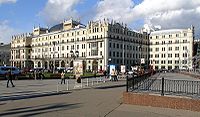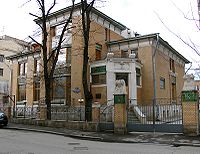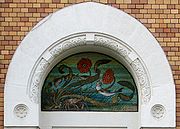
William Walcot
Encyclopedia
William Walcot was a British architect
graphic artist and etcher, notable as a practitioner of refined Art Nouveau
(Style Moderne) in Moscow
, Russia (as Вильям Францевич Валькот). His trademark Lady's Head keystone
ornament became the easily recognizable symbol of Russian Style Moderne. In 1920s-1930s, he concentrated on graphic art and was praised as the best architectural draftsman in London.
in a mixed Scottish-Russian family. He grew up in Western Europe and South Africa, returning to Russia at the age of 17, and studied arts and architecture under Leon Benois
at the Imperial Academy of Arts
in Saint Petersburg
. Later, he attended art schools in Paris. Walcot's career as an architect in Moscow lasted only six years, but he managed to leave a lasting heritage of refined, pure Art Nouveau
. Unlike contemporary architects like Fyodor Schechtel
, Walcot never ventured into Neo-Gothic or Russian Revival
styles - his work is strictly Art Nouveau, in its English Decadent variety (according to contemporary Russian critics).
 His largest and best known work was the Metropol Hotel
His largest and best known work was the Metropol Hotel
, financed by Savva Mamontov
. The spacious building, now operating as a hotel only, was conceived as a cultural center around Private Opera
hall. In 1899, Walcot applied to the open contest with a draft codenamed A Lady's Head (Женская головка), earning the fourth prize and losing to Lev Kekushev
. However, Mamontov discarded the professional jury decision, and awarded the design to Walcot (Lev Kekushev later joined the team as project manager). More than once, Walcot's original plans were changed in the process; in fact, there is little common between extant building and his 1899 draft (Brumfield, fig.56) - but the Lady's Head persisted in main hall ornaments. The building, completed in 1905 after a devastating fire in 1901, was decorated by Mikhail Vrubel
, Alexander Golovin, Nikolai Andreev and other artists. Participation of Victor Vesnin and Fyodor Schechtel
, suggested by William Brumfield, has not been confirmed.
Lady's Head became Walcot's trademark, repeated in his later works (usually in place of an arch keystone
), and frequently imitated by local craftsmen. For a while, he enjoyed an unprecedented flow of inquiries and could secure two high-profile commissions of his own choice. These buildings, soon occupied by foreign embassies, are well maintained and retain most of their original interiors:
Walcot's mosaic
, signed W.W., adorns the List House in Glazovsky Lane, built by Lev Kekushev
.
Walcot's 1902 draft for the Lutheran Cathedral in Moscow won the contest, but the cathedral was eventually built to another architect's design. Walcot published various drafts in architectural magazines, influencing many local architects (Brumfield, fig.58).
In 1904, Walcot lost the contest for the Polytechnical Society Building in Myasnitskaya Street to Adolph Mincus; the building, completed in 1905-1907 by Alexander Kuznetsov (1874–1954), bears some details from Walcot's rejected draft.
 In 1906, Walcot relocated to London. There he was initially employed as a draughtsman for the South African architect Eustace Frere. He rarely returned to practical construction, designing only one London building: 61 St James's Street (1933). Rather, Walcot worked as an architectural draftsman
In 1906, Walcot relocated to London. There he was initially employed as a draughtsman for the South African architect Eustace Frere. He rarely returned to practical construction, designing only one London building: 61 St James's Street (1933). Rather, Walcot worked as an architectural draftsman
, famous for his artistic presentation of other architects' designs and exhibiting his own work at the Royal Academy summer exhibitions.
He was the most prominent architectural draughtsman of the 1920s and 30s, developing a somewhat impressionistic style in gouache
and watercolour which won commissions from Edwin Lutyens
, Herbert Baker
and Aston Webb
. He also engaged in printmaking, creating reconstructions of ancient Greek, Roman, Babylonian and Egyptian buildings. A folio of his work was published in 1919 as Architectural Watercolours and Etchings of William Walcot. He was elected to the Royal Society of British Artists in 1913, as an associate of the Royal Society of Painter-Etchers and Engravers in 1916 and a Fellow of the RIBA in 1922. He was also an associate of the British School at Rome.
Walcot's successful practice was ruined with the outbreak of World War II, and, in 1943, Walcot committed suicide at Hurstpierpoint
, Sussex
. Walcot's painting and etchings are frequently exhibited; his painting palette
is preserved at the Royal Institute of British Architects
. He had a retrospective exhibition at the Fine Arts Society in 1974.

Architect
An architect is a person trained in the planning, design and oversight of the construction of buildings. To practice architecture means to offer or render services in connection with the design and construction of a building, or group of buildings and the space within the site surrounding the...
graphic artist and etcher, notable as a practitioner of refined Art Nouveau
Art Nouveau
Art Nouveau is an international philosophy and style of art, architecture and applied art—especially the decorative arts—that were most popular during 1890–1910. The name "Art Nouveau" is French for "new art"...
(Style Moderne) in Moscow
Moscow
Moscow is the capital, the most populous city, and the most populous federal subject of Russia. The city is a major political, economic, cultural, scientific, religious, financial, educational, and transportation centre of Russia and the continent...
, Russia (as Вильям Францевич Валькот). His trademark Lady's Head keystone
Keystone (architecture)
A keystone is the wedge-shaped stone piece at the apex of a masonry vault or arch, which is the final piece placed during construction and locks all the stones into position, allowing the arch to bear weight. This makes a keystone very important structurally...
ornament became the easily recognizable symbol of Russian Style Moderne. In 1920s-1930s, he concentrated on graphic art and was praised as the best architectural draftsman in London.
Russia
William Walcot was born at Lustdorf, near OdessaOdessa
Odessa or Odesa is the administrative center of the Odessa Oblast located in southern Ukraine. The city is a major seaport located on the northwest shore of the Black Sea and the fourth largest city in Ukraine with a population of 1,029,000 .The predecessor of Odessa, a small Tatar settlement,...
in a mixed Scottish-Russian family. He grew up in Western Europe and South Africa, returning to Russia at the age of 17, and studied arts and architecture under Leon Benois
Leon Benois
Leon Benois was a Russian architect. He was the son of architect Nicholas Benois, the brother of artists Alexandre Benois and Albert Benois, and the grandfather of the actor Sir Peter Ustinov...
at the Imperial Academy of Arts
Imperial Academy of Arts
The Russian Academy of Arts, informally known as the St. Petersburg Academy of Arts, was founded in 1757 by Ivan Shuvalov under the name Academy of the Three Noblest Arts. Catherine the Great renamed it the Imperial Academy of Arts and commissioned a new building, completed 25 years later in 1789...
in Saint Petersburg
Saint Petersburg
Saint Petersburg is a city and a federal subject of Russia located on the Neva River at the head of the Gulf of Finland on the Baltic Sea...
. Later, he attended art schools in Paris. Walcot's career as an architect in Moscow lasted only six years, but he managed to leave a lasting heritage of refined, pure Art Nouveau
Art Nouveau
Art Nouveau is an international philosophy and style of art, architecture and applied art—especially the decorative arts—that were most popular during 1890–1910. The name "Art Nouveau" is French for "new art"...
. Unlike contemporary architects like Fyodor Schechtel
Fyodor Schechtel
Fyodor Osipovich Schechtel was a Russian architect, graphic artist and stage designer, the most influential and prolific master of Russian Art Nouveau and late Russian Revival....
, Walcot never ventured into Neo-Gothic or Russian Revival
Russian Revival
The Russian Revival style is the generic term for a number of different movements within Russian architecture that arose in second quarter of the 19th century and was an eclectic melding of pre-Peterine Russian architecture and elements of Byzantine architecture.The Russian Revival style arose...
styles - his work is strictly Art Nouveau, in its English Decadent variety (according to contemporary Russian critics).

Hotel Metropol (Moscow)
Hotel Metropol is a historical hotel in the center of Moscow, Russia, built in 1899-1907 in Art Nouveau style. It is notable as the largest extant Moscow hotel built before the Russian Revolution of 1917, and for the unique collaboration of architects and artists .In 1898, Savva Mamontov...
, financed by Savva Mamontov
Savva Mamontov
Savva Ivanovich Mamontov was a famous Russian industrialist, merchant, entrepreneur, and patron of the arts.-Biography:He was a son of the wealthy merchant and industrialist Ivan Feodorovich Mamontov and Maria Tikhonovna . In 1841 the family moved to Moscow. From 1852 he studied in St...
. The spacious building, now operating as a hotel only, was conceived as a cultural center around Private Opera
Private Opera
The Private Opera , also known as:*The Russian Private Opera ;*Moscow Private Russian Opera, ;*Mamontov's Private Russian Opera in Moscow ;*Korotkov's Theatre ;*Vinter's Theatre ;*Private Opera Society ; and...
hall. In 1899, Walcot applied to the open contest with a draft codenamed A Lady's Head (Женская головка), earning the fourth prize and losing to Lev Kekushev
Lev Kekushev
Lev Nikolayevich Kekushev was a Russian architect, notable for his Art Nouveau buildings in Moscow, built in the 1890s and early 1900s in the original, Franco-Belgian variety of this style...
. However, Mamontov discarded the professional jury decision, and awarded the design to Walcot (Lev Kekushev later joined the team as project manager). More than once, Walcot's original plans were changed in the process; in fact, there is little common between extant building and his 1899 draft (Brumfield, fig.56) - but the Lady's Head persisted in main hall ornaments. The building, completed in 1905 after a devastating fire in 1901, was decorated by Mikhail Vrubel
Mikhail Vrubel
Mikhail Aleksandrovich Vrubel is usually regarded amongst the Russian painters of the Symbolist movement. In reality, he deliberately stood aloof from contemporary art trends, so that the origin of his unusual manner should be sought in Late Byzantine and Early Renaissance painting.-Early...
, Alexander Golovin, Nikolai Andreev and other artists. Participation of Victor Vesnin and Fyodor Schechtel
Fyodor Schechtel
Fyodor Osipovich Schechtel was a Russian architect, graphic artist and stage designer, the most influential and prolific master of Russian Art Nouveau and late Russian Revival....
, suggested by William Brumfield, has not been confirmed.
Lady's Head became Walcot's trademark, repeated in his later works (usually in place of an arch keystone
Keystone (architecture)
A keystone is the wedge-shaped stone piece at the apex of a masonry vault or arch, which is the final piece placed during construction and locks all the stones into position, allowing the arch to bear weight. This makes a keystone very important structurally...
), and frequently imitated by local craftsmen. For a while, he enjoyed an unprecedented flow of inquiries and could secure two high-profile commissions of his own choice. These buildings, soon occupied by foreign embassies, are well maintained and retain most of their original interiors:
- 1899-1900 Yakunchikova House (Prechistensky lane, 10)
- 1902-1903 Gutheil House (Prechistensky lane, 8, Embassy of MoroccoMoroccoMorocco , officially the Kingdom of Morocco , is a country located in North Africa. It has a population of more than 32 million and an area of 710,850 km², and also primarily administers the disputed region of the Western Sahara...
)
Walcot's mosaic
Mosaic
Mosaic is the art of creating images with an assemblage of small pieces of colored glass, stone, or other materials. It may be a technique of decorative art, an aspect of interior decoration, or of cultural and spiritual significance as in a cathedral...
, signed W.W., adorns the List House in Glazovsky Lane, built by Lev Kekushev
Lev Kekushev
Lev Nikolayevich Kekushev was a Russian architect, notable for his Art Nouveau buildings in Moscow, built in the 1890s and early 1900s in the original, Franco-Belgian variety of this style...
.
Walcot's 1902 draft for the Lutheran Cathedral in Moscow won the contest, but the cathedral was eventually built to another architect's design. Walcot published various drafts in architectural magazines, influencing many local architects (Brumfield, fig.58).
In 1904, Walcot lost the contest for the Polytechnical Society Building in Myasnitskaya Street to Adolph Mincus; the building, completed in 1905-1907 by Alexander Kuznetsov (1874–1954), bears some details from Walcot's rejected draft.
United Kingdom

Technical drawing
Technical drawing, also known as drafting or draughting, is the act and discipline of composing plans that visually communicate how something functions or has to be constructed.Drafting is the language of industry....
, famous for his artistic presentation of other architects' designs and exhibiting his own work at the Royal Academy summer exhibitions.
He was the most prominent architectural draughtsman of the 1920s and 30s, developing a somewhat impressionistic style in gouache
Gouache
Gouache[p], also spelled guache, the name of which derives from the Italian guazzo, water paint, splash or bodycolor is a type of paint consisting of pigment suspended in water. A binding agent, usually gum arabic, is also present, just as in watercolor...
and watercolour which won commissions from Edwin Lutyens
Edwin Lutyens
Sir Edwin Landseer Lutyens, OM, KCIE, PRA, FRIBA was a British architect who is known for imaginatively adapting traditional architectural styles to the requirements of his era...
, Herbert Baker
Herbert Baker
Sir Herbert Baker was a British architect.Baker was the dominant force in South African architecture for two decades, 1892–1912....
and Aston Webb
Aston Webb
Sir Aston Webb, RA, FRIBA was an English architect, active in the late 19th century and at the beginning of the 20th century...
. He also engaged in printmaking, creating reconstructions of ancient Greek, Roman, Babylonian and Egyptian buildings. A folio of his work was published in 1919 as Architectural Watercolours and Etchings of William Walcot. He was elected to the Royal Society of British Artists in 1913, as an associate of the Royal Society of Painter-Etchers and Engravers in 1916 and a Fellow of the RIBA in 1922. He was also an associate of the British School at Rome.
Walcot's successful practice was ruined with the outbreak of World War II, and, in 1943, Walcot committed suicide at Hurstpierpoint
Hurstpierpoint
Hurstpierpoint is a village in the Mid Sussex district of West Sussex, England. Together with Sayers Common it forms one of the Mid Sussex civil parishes, with an area of 2029.88 ha and a population of 6,264 persons....
, Sussex
Sussex
Sussex , from the Old English Sūþsēaxe , is an historic county in South East England corresponding roughly in area to the ancient Kingdom of Sussex. It is bounded on the north by Surrey, east by Kent, south by the English Channel, and west by Hampshire, and is divided for local government into West...
. Walcot's painting and etchings are frequently exhibited; his painting palette
Palette (painting)
A palette , in the original sense of the word, is a rigid, flat surface on which a painter arranges and mixes paints. A palette is usually made of wood, plastic, ceramic, or other hard, inert, nonporous material, and can vary greatly in size and shape...
is preserved at the Royal Institute of British Architects
Royal Institute of British Architects
The Royal Institute of British Architects is a professional body for architects primarily in the United Kingdom, but also internationally.-History:...
. He had a retrospective exhibition at the Fine Arts Society in 1974.
Further reading
- Architectural water-colours & etchings of William Walcot (London: H.C. Dickins, 1919).
External links


